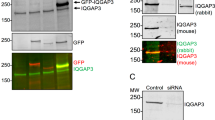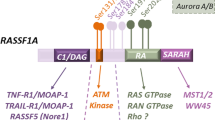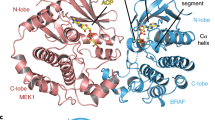Abstract
The Dok adaptor family of proteins binding to RasGAP, consisting of Dok-1 and Dok-2, are critical regulators in cell proliferation. These molecules are partners and/or substrates of different protein tyrosine kinases considered as oncoproteins. Here, we show that Dok-1 and Dok-2 are the major tyrosine-phosphorylated proteins associated to Tec, a protein tyrosine kinase expressed in T cells. Furthermore, we evaluate the effect of Dok-1 or Dok-2 on Tec-mediated signalling pathways in T cells. Here, we provide evidence that Dok-1 and Dok-2 proteins are involved in a negative feedback regulation of Tec via a downregulation of its tyrosine phosphorylation and downstream signalling pathways including the Ras pathway. Either Dok-1 or Dok-2 therefore represents a mean of potent retrograde control for protein tyrosine kinase signalling, and then possibly of tumor development.
This is a preview of subscription content, access via your institution
Access options
Subscribe to this journal
Receive 50 print issues and online access
$259.00 per year
only $5.18 per issue
Buy this article
- Purchase on Springer Link
- Instant access to full article PDF
Prices may be subject to local taxes which are calculated during checkout



Similar content being viewed by others
References
Bhat A, Johnson KJ, Oda T, Corbin AS and Druker BJ . (1998). J. Biol. Chem., 273, 32360–32368.
Carpino N, Wisniewski D, Strife A, Marshak D, Kobayashi R, Stillman B and Clarkson B . (1997). Cell, 88, 197–204.
Clarkson B and Strife A . (1993). Leukemia, 7, 1683–1721.
Di Cristofano A, Carpino N, Dunant N, Friedland G, Kobayashi R, Strife A, Wisniewski D, Clarkson B, Pandolfi PP and Resh MD . (1998). J. Biol. Chem., 273, 4827–4830.
Di Cristofano A, Niki M, Zhao M, Karnell FG, Clarkson B, Pear WS, Van Aelst L and Pandolfi PP . (2001). J. Exp. Med., 194, 275–284.
Gugasyan R, Quilici C, Stacey TTI, Grail D, Verhagen AM, Roberts A, Kitamura T, Dunn AR and Lock P . (2002). J. Cell Biol., 158, 115–125.
Guy GR, Yusoff P, Bangarusamy D, Fong CW and Wong ES . (2002). Cell Signal., 14, 11–20.
Izquierdo M, Leevers SJ, Marshall CJ and Cantrell D. . (1993). J. Exp. Med., 178, 1199–1208.
Jones N and Dumont DJ . (1999). Curr. Biol., 9, 1057–1060.
Liang X, Wisniewski D, Strife A, Shivakrupa Clarkson B and Resh MD . (2002). J. Biol. Chem., 277, 13732–13738.
Master Z, Tran J, Bishnoi A, Chen SH, Ebos JM, Van Slyke P, Kerbel RS and Dumont DJ . (2003). J. Biol. Chem., 278, 30170–30179.
Miller AT and Berg LJ . (2002). Curr. Opin. Immunol., 14, 331–340.
Nelms K, Snow AL, Hu-Li J and Paul WE . (1998). Immunity, 9, 13–24.
Némorin JG and Duplay P . (2000). J. Biol. Chem., 275, 14590–14597.
Némorin JG, Laporte P, Bérubé G and Duplay P . (2001). J. Immunol., 166, 4408–4415.
Nunès JA, Truneh A, Olive D and Cantrell DA . (1996). J. Biol. Chem., 271, 1591–1598.
Shah K and Shokat KM . (2002). Chem. Biol., 9, 35–47.
van Dijk TB, van Den Akker E, Amelsvoort MP, Mano H, Löwenberg B and von Lindern M . (2000). Blood, 96, 3406–3413.
Yamanashi Y, Tamura T, Kanamori T, Yamane H, Nariuchi H, Yamamoto T and Baltimore D. . (2000). Genes Dev., 14, 11–16.
Yang WC, Collette Y, Nunès JA and Olive D . (2000a). Immunity, 12, 373–382.
Yang WC, Ghiotto M, Barbarat B and Olive D . (1999). J. Biol. Chem., 274, 607–617.
Yang WC, Ghiotto M, Castellano R, Collette Y, Auphan N, Nunès JA and Olive D . (2000b). Int. Immunol., 12, 1547–1552.
Yoshida K, Yamashita Y, Miyazato A, Ohya K, Kitanaka A, Ikeda U, Shimada K, Yamanaka T, Ozawa K and Mano H . (2000). J. Biol. Chem., 275, 24945–24952.
Acknowledgements
We thank Professor MD Resh and Drs DA Cantrell, J Ihle, Y Yamanashi for kindly providing reagents and Dr H-T He for helpful discussions. We are grateful to Marie-Claire and Peter Gerhards for the correction of the manuscript. This research was supported by the Institut National de la Santé et de la Recherche Médicale, by Grant 4330 from the Association pour la recherche contre le Cancer, by grants from the Canadian Institutes of Health Research (CIHR) to P Duplay and a grant ‘équipe labellisée 2001’ from the Ligue Nationale Contre le Cancer. C Favre was supported by a fellowship from the Association pour la recherche contre le Cancer. F Garçon was supported by a fellowship from the Ligue Nationale Contre le Cancer. P Duplay is a CIHR New Investigator.
Author information
Authors and Affiliations
Corresponding author
Rights and permissions
About this article
Cite this article
Gérard, A., Favre, C., Garçon, F. et al. Functional interaction of RasGAP-binding proteins Dok-1 and Dok-2 with the Tec protein tyrosine kinase. Oncogene 23, 1594–1598 (2004). https://doi.org/10.1038/sj.onc.1207283
Received:
Revised:
Accepted:
Published:
Issue Date:
DOI: https://doi.org/10.1038/sj.onc.1207283
Keywords
This article is cited by
-
Commercial Initiation of Feather Hydrolysate as Supreme Fertilizer: A Smart Bio-Cleaning Strategy of Poultry Waste
Waste and Biomass Valorization (2023)
-
Region-Specific Dok2 Overexpression Associates with Poor Prognosis in Human Astrocytoma
Molecular Neurobiology (2018)
-
Production and purification of keratinase using chicken feather bioconversion by a newly isolated Aspergillus fumigatus TKF1: detection of valuable metabolites
Biomass Conversion and Biorefinery (2014)
-
Rap1GAP interacts with RET and suppresses GDNF-induced neurite outgrowth
Cell Research (2011)
-
Dok2
AfCS-Nature Molecule Pages (2008)



